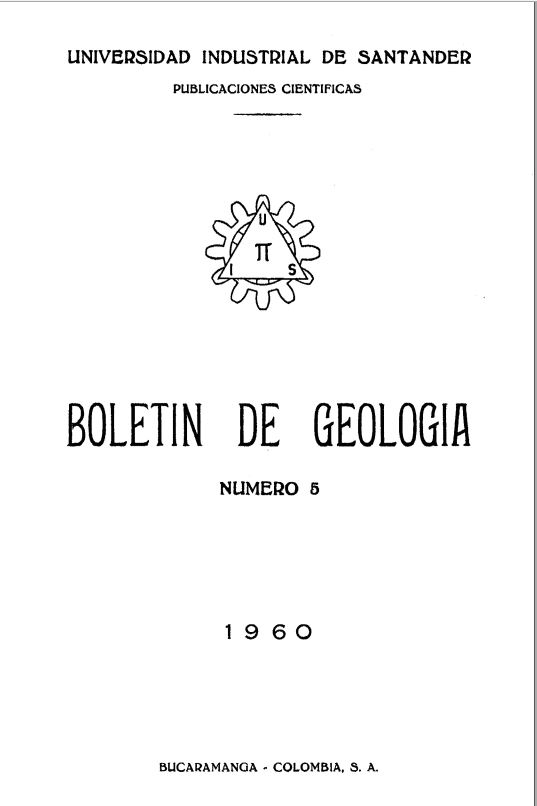Published 1960-12-04
How to Cite
Abstract
RESUMEN. —
Se estudia la zona cretácica que forma el límite E del macizo de Santander; en el sector de García Rovira. El cretácico en esta zona presenta un espesor inferior a los 2.000 m. Sus rasgos más característicos son, su carácter transgresivo sobre el macizo y el aumento en importancia de los niveles de areniscas, en comparación con las áreas situadas al W del macizo de Santander. Por lo que respecta a la formación Girón (jura-triásico), es de destacar que falta a todo lo largo del borde del macizo, aparece muy reducida algo más al E y va aumentando progresivamente de espesor hacia el oriente aunque sin llegar a sobrepasar los 150 m; al W del macizo el Girón aumenta también de espesor al ir alejándose del mismo pero este incremento de espesor es mucho más rápido. Desde el punto de vista tectónico pueden distinguirse tres unidades, dos áreas de tipo sinclinal orientadas de N a S y entre ellas un área compleja anticlinal. Los contactos entre este complejo anticlinal y las zonas sinclinales que lo limitan son fallados. El complejo anticlinal tiende a ser algo extrusivo cabalgando ligeramente ambas áreas sinclinales limitantes. El estilo tectónico de la región es un estilo de pliegues y fallas que contrasta vivamente con la estructura al W del macizo de Santander que es muy simple, de grandes bloques limitados por fallas casi verticales; es de señalar que esta región tabular se sitúa precisamente al W del macizo donde el espesor del mesozoico es mayor que en la zona al E del mismo, en la cual se desarrolla una tectónica de pliegues y fallas.
ABSTRACT.—
This is a study of the cretaceous witch in the García Rovira area forms the easter limit of the Santander Massif. The cretaceous here has a thickness of less than 2.000 meters. Its most characteristic features are its transgressive character on the massif and the increase in importance of the sandstone horizons as compared with the areas situated to the west of the Santander Mas-sif. With regard to the Giron Formation (Jura-Trias) it should be pointed out that it is missing along the whole border of the Massif; it appears on a very minor scale somewhat further to the east where it increases in thickness as one recedes from it, but here this increase is far more rapid. From the tectonic point of view three units can be observed: two of a synclinal tipe with a N-S trend and between them a complex anticlinal area. The contacts between this anticlinal complex and the neighboring synclinal zones are faults. The anticlinal zone tends to be somewhat extrusive and is slightly overthrust on both the neighboring areas. The tectonics of the region are characterized by a series of folds and faults which contrast vividly with the structure to the west of the Santander Massif which is very simple and there consist of large blocks delimited by almost vertical faults, it should be pointed out that in this block faulted zone immediately to the west of the massif the sedimentary section (Giron + Cretaceous) is far thicker than in the zone to the east of the massif where there is a deveIopment consisting of folds and faults.
RESUME.—
On fait l'étude du mésozoïque du secteur W de Garcia Rovira, lequel constitue la limite E du massif de Santander. L'épaisseur du cretacé n'atteint les 2.000 m; ses traits les plus remarquables sont, le caractère trans-gressif sur le massif et la présence de niveaux de grès baucoup plus importants et nombreux que ceux qui affleurent du côté W du massif. La formation Giron (jura-triasique) manque tout le long du bord du massif, apparait vers l'Est et son épaisseur augmente progressivement jusqu'à atteindre à peu près 150 m; à l'Ouest du massif le Giron se fait de plus en plus épais vers l'occident, c'est à dire que le Giron s'amincit et disparaît sur le massif. Du point de vue tectonique on aperçoit trois unités orientées N-S, un complexe anticlinal limité par deux unités sinclinales. Les contacts du complexe anticlinal avec les unités qui le limitent à l'Est et l'Ouest sont des failles inverses ce qui donne au complexe anticlinal une allure légèrement extrusive. La tectonique vient caractérisée par la présence de plis et de failles, ce qui contraste avec la structure très simple à l'Ouest du massif, cette structure est constitué par des grands blocs à couches horizontales limités par des failles. On doit remarquer que cette structure si simple se developpe à l'Ouest du massif où le mésozoïque (Giron + Cretacé) est plus épais que du côté E.
